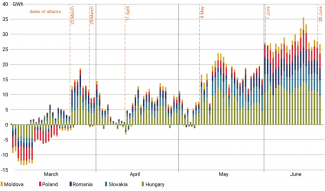Ukraine: the energy infrastructure crisis and the potential for a new wave of refugees
20 June saw another combined rocket and UAV strike on energy infrastructure facilities. Since March 2024, when Russia resumed its massive shelling campaigns, Ukraine has lost around half of its installed capacity, resulting in power outages across the country, which occur almost daily and last many hours. Despite the ongoing repair work and purchases of new electricity generation equipment, next winter will be arduous and forced power outages may last up to 20 hours daily.
The consequences of damage to heating and power plants which provide central heating to big cities will pose an even bigger challenge. However, although they may be more troublesome than power outages, possible heating outages will be local.
It seems that power outages will not trigger a major wave of migration with the onset of cold weather. Although an increased inflow of refugees to Poland and other EU member states may occur, the majority of the affected individuals will most likely relocate to villages and towns in Ukraine.
Damage to energy infrastructure
The attack carried out on 20 June once again damaged the Ladyzhyn Thermal Power Plant and unspecified elements of energy infrastructure in Kyiv, Dnipropetrovsk, and Donetsk Oblasts. As a result of massive shelling campaigns over the last several months, around 80–90% of Ukraine’s energy generation capacity at thermal power plants and around 45% at hydroelectric power plants has been lost. This accounts for a total of 9.2 GW of installed capacity out of around 18–20 GW which was available prior to the attacks (this included 7.8 GW of energy generation capacity at nuclear power plants). The Trypilska Thermal Power Plant near Kyiv and the thermal power plant no. 5 in Kharkiv, which supplies heating to 30–50% of the city’s residents, have reportedly been destroyed. Thermal and hydroelectric power plants are of key importance to balancing the grid throughout the day.
It is difficult to assess which facilities have been destroyed (their reconstruction will last at least a year) and which have only suffered major damage and could be repaired within a few months. According to some estimates, Ukraine may be able to restore up to 2 GW of energy generation capacity, partly by utilising disassembled equipment from decommissioned power plants in former Communist bloc countries, which several states, including Lithuania, Estonia and Germany have decided to donate to Ukraine. In addition, the preparation of alternative sources of electricity is ongoing. It involves the local authorities and representatives of businesses purchasing and installing power generators and small turbines. Currently, it is difficult to assess the scale of these purchases and the date of completing the installation work (the majority of these facilities will likely be put into operation no sooner than next year).
Since March 2022, the Ukrainian electricity grid has been connected to the EU grid, which enables Ukraine to receive support from neighbouring states. Following this year’s first massive attack, which occurred in March, Kyiv effectively halted its electricity exports and began to import electricity. Starting from 8 May, its imports grew, and on some days, they exceeded 30,000 MWh daily, which accounted for more than 10% of electricity generated in Ukraine. While in March, Ukraine purchased 169,000 MWh of power; in April, 225,000 MWh; in May, 450,000 MWh and in the first 21 days of June, 592,000 MWh.
Chart. Ukraine’s daily electricity exports (-) and imports (+) between March and 21 June 2024

Source: ENTSO-E.
Ukraine’s increasing problems in the energy sector are evidenced by the fact that since May its electricity imports from neighbouring countries in the evening hours have repeatedly come close to the 1.7 GW maximum capacity limit and that Ukraine began to import large volumes of electricity at night. The latter development indicates that it is unable to meet its demand even in the period of the lowest electricity consumption. According to media reports, Kyiv has initiated discussions with its neighbours to increase the grid’s maximum capacity to 2–2.4 GW, which could boost the Ukrainian electricity system. However, this would require technical work on both sides of the border to enable the grid to dispatch and receive greater amounts of electricity.
The Russian attacks have resulted in emergency and planned power outages, initially affecting industrial clients (except for the defence industry) and subsequently also individual customers. In the coming weeks, the duration of power shutdowns will increase (up to more than ten hours daily) due to the planned repair of nuclear-fired units. The situation will provisionally improve in early autumn due to the seasonal drop in electricity consumption and the resumption of operations at all nuclear power plants.
The potential for migration
In the event of a harsh winter combined with electricity and heating outages, it is likely that the inflow of refugees to Poland and other EU member states will increase. However, the magnitude of this inflow will be much smaller than at the beginning of the war. Many Ukrainians have adapted to water and electricity supply problems and believe that they will be able to get through another heating season. The scale and destinations of migration will depend on how effectively the local authorities prepare for the winter (for example whether they procure enough power generators to enable the operation of heat pumps) and on the government’s information policy to prepare citizens for possible major heating problems.
Electricity shortages may indirectly trigger emigration by causing disruptions in company operations. This may urge business owners to close their companies or reduce their workforce, which, in turn, may cause financial problems to many individuals. These problems are often cited as one of the main reasons to emigrate.
At the same time, opinion polls indicate that Ukrainians do not view electricity problems as a direct cause for their intention to relocate (both abroad and internally). According to a Gradus Research survey conducted in March 2024, the most important reasons for leaving one’s place of residence were concerns about personal or family security (58%), the loss of one’s property (35%), an uncertain future (35%), financial problems (32%) and a lack of employment opportunities (32%). Just 15% of the respondents cited limited access to water or electricity as the main reason for their relocation.
Generally, a mere 18% of Ukrainians considered leaving the country should the war situation worsen, 32% of them would like to relocate but are unable to do so due to various reasons, and 51% of the surveyed individuals declared that they did not plan to leave. The survey was carried out prior to the recent wave of Russia’s massive strikes on energy infrastructure, that is, before the series of troublesome power outages. However, it shows that a sizeable proportion of individuals who were able to leave Ukraine have already left and those who stayed are not very mobile due to financial or family reasons.
The evacuation of the civilian population from the conflict zones in Kharkiv Oblast in May and June seems to partially corroborate these findings. Since 8 May, around 12,000 individuals have fled these regions. Among them, 10,000 relocated to Kharkiv, many of whom had family or jobs there). According to Deputy Prime Minister Iryna Vereshchuk, the majority of the evacuees who relocated to Kharkiv are planning to stay there for the winter and do not intend to leave, despite frequent Russian shelling.
Outlook
There is no doubt that the coming winter will be arduous due to outages in the power and heating supply to households and industrial plants. At present, it is difficult to predict their duration and severity because they will depend on several key factors. It is unclear how much power generation capacity will be available before the start of the heating season, which de facto begins with the onset of sub-zero temperatures. Other important factors include the pace and scope of repair work at thermal power plants and heating and power plants. It should be noted that the Russians frequently shell facilities which had previously suffered damage from an attack.
Much will also depend on average daily temperature and weather conditions which could enable the production of electricity from RES (before the war Ukraine’s electricity consumption in individual winter months varied by up to 20% depending on the temperature). However, the key factor, which is impossible to predict, will be the effectiveness of Russian strikes on energy infrastructure in the coming months. Aside from Kyiv, which is relatively well protected by air defence systems, Ukraine is unable to protect its energy infrastructure in the event of a massive rocket and UAV attack.
Although shelling of nuclear power plant units continues to be unlikely, it cannot be ruled out that power distribution substations and transmission lines may be targeted. Since the beginning of the war, there have been four instances of an emergency shutdown of a nuclear power plant due to such attacks (excluding the occupied Zaporizhzhia Nuclear Power Plant). Depending on the severity of the damage, the duration of repair work may range from several hours to approximately two weeks. Moreover, emergency shutdowns of specific units are likely due to technical reasons. Depending on the situation, wintertime power outages may last from several hours (this is an overly optimistic scenario) to more than 20 hours daily, and in some periods, they may even last several days.
The heating and power plants which provide central heating to Ukraine’s big cities seem to be particularly vulnerable. In winter, problems with central heating in cities which depend heavily on large heating and power plants may pose a far more serious challenge than power outages. Since the beginning of the full-scale invasion there have been instances of damage to such facilities. Besides Kharkiv, these incidents also occurred in Chernihiv, Kyiv and other cities, although the severity of the damage is unclear. Should Russia destroy heating and power plants in big cities, the Ukrainian authorities will effectively be unable to provide alternative heating to a significant portion of these cities’ residents. It should be noted that unlike the electricity grid, which covers the entire country and is integrated into the grids of neighbouring states, central heating is provided by local systems. Thus, heating problems will be limited to those cities in which the local heating and power plant suffers damage.
In this situation, it appears that instead of relocating abroad, Ukrainians will choose to move to other regions within Ukraine, where they have relatives, job opportunities, or where heating and power supply issues are less severe. The most likely destinations will be villages, as residents there are allowed to burn coal and wood for heating. Notably, Ukraine has a significant stockpile of coal (2.4 mln tonnes), which continues to grow due to damage to the majority of coal-fired power plants. This suggests that in an emergency, coal could be widely used as fuel in individual furnaces, coke burning stoves and similar appliances. A similar situation exists regarding the stockpile of wood.
The Ukrainian government will aim to avoid evacuating residents from major cities, particularly Kharkiv, as this could have negative reputational consequences and indicate that Russia’s intimidation tactics are effective.





